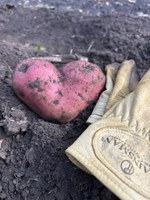Dakota Gardener: A thankful gardener
(Click an image below to view a high-resolution image that can be downloaded)
By Carrie Knutson, Horticulture agent
NDSU Extension – Grand Forks County
The gardening season has officially ended. Hopefully, you have everything ready for winter and are ready to enjoy the holiday season. As I prepare for the holiday season, I am also taking time to reflect on the improvements needed and the success of my garden this growing season. I am writing notes now, so that I don’t forget things over the long winter and go into the next growing season unprepared.
What notes have you written about your garden? Do you have areas for improvement or things that went well? To start, I have three areas for improvement next year. The first is to provide correct row spacing for my squash and pumpkins. I planted my rows too close together this year, and timely rains caused the squash to grow crazy-wild, crowding out my miniature pumpkins and gourds.
The second improvement would be to decrease the number of tomatoes I plant. The correct number of tomato plants for me is in the single, not double, digits. I need to give myself permission to compost or give away my extra tomato seedlings. I made four batches of salsa, froze and dehydrated numerous batches of tomatoes and also supplied my mom and dad with tomatoes. I eventually resorted to putting large boxes of tomatoes in my co-workers' vehicles so they wouldn’t go to waste (I did have permission).
The third area for improvement is to start a second set of kale transplants later in the season. During the heat of the summer, I don’t eat as much of it, and by then, the imported cabbageworm caterpillars have eaten their fill. By transplanting a second set in August, I hope to miss the cabbageworms and have a better fall harvest.
What successes did you have in your garden? I was fortunate to have a good growing season, but two items stood out. One is the continued use of no-till practices in my home garden plots. It is amazing to see how the soil structure has changed. I have heavy clay soil and didn’t get my carrots out before the rain. I was surprised that the carrots were easy to dig. Instead of being heavy and sticky, the soil had a granular texture and was easy to work with.
Another success would be the salvia I started from seed. The plants withstood the growing season's extremes and continued to feed pollinators through October. I saved some seeds and am looking forward to starting next year’s crop.
Oftentimes, we focus on the amount of nourishing food or beautiful blooms we get from our garden as a measure of success. But how about some things that aren’t as tangible? Our gardens connect us with nature, reducing our stress (don’t think about the work) and providing a calm environment that allows our attention to wander and our curiosity to grow.
We are also able to care for our landscape by providing habitats for birds, bees and other wildlife. That is something we all should be thankful for this season. Happy gardening!
NDSU Agriculture Communication – Nov. 25, 2025
Source: Carrie Knutson, 701-780-8229, carrie.knutson@ndsu.edu
Editor: Dominic Erickson, 701-231-5546, dominic.erickson@ndsu.edu




